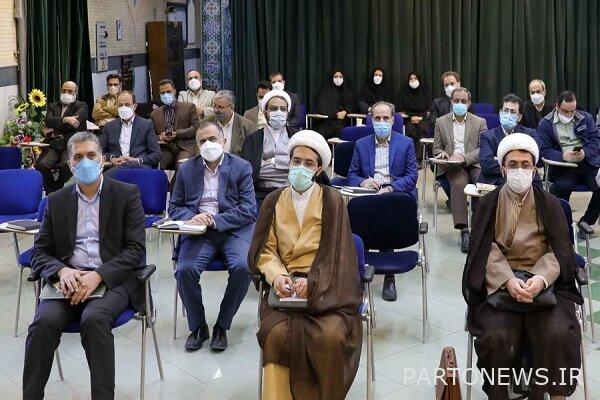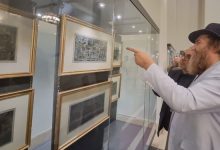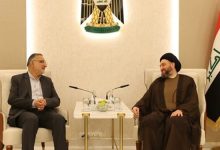The need for effective communication between the research organization and Farhangian University – Mehr News Agency Iran and world’s news

According to Mehr News Agency, Public Relations and International Affairs of the Educational Research and Planning Organization, at the beginning of the meeting, Hojjatoleslam and Muslims Ali Latifi, head of the Educational Research and Planning Organization, while congratulating the Eid al-Fitr and Imam Hussein’s birthday, continued communication He considered the relationship between the Research and Educational Planning Organization and Farhangian University as an important element in achieving the goals of the formal education system.
While celebrating Islamic Education Week, Latifi stressed the need to expand the relationship between Farhangian University and the Research Organization and said: “It is clear that among the most qualified people to play a role in designing and compiling educational content, professors and activists in the teacher education system such as Farhangian University And they are Shahid Rajaei University and it is necessary to reduce the distances between these two departments in order to improve this mapping. Unfortunately, it seems that in the past years, for various reasons, these two groups have become slightly different from each other, and this has caused a lot of damage to the educational system. Therefore, we must take serious steps to solve this problem and have a continuous relationship with different departments of Farhangian University.
The head of the Educational Research and Planning Organization added: “The lack of sufficient communication between the organization and the educational body of the country, such as professors of Farhangian University and teachers, has various reasons and the organization intends to strengthen this relationship by taking more serious measures.” On this basis, I hope that such meetings and programs can help further the development of Farhangian University and the research organization.
Hojjatoleslam Latifi called the measures taken at Farhangian University in recent years positive and said: “Based on the contacts I have had with Farhangian University in the past, I believe that good transformational steps have been taken at this university, which, like any other action, needs to be completed.” Is.
He added: “One of the measures of Farhangian University is a special type of architecture in the curriculum of this university, which familiarity and serious involvement of the experts of the research organization with it, can help the growth of both complexes.”
It is necessary to pay attention to the developments in the society in teacher training courses
In the continuation of the meeting, Mehdi Namdari Pejman, Director General of Scientific Publishing and Information of Farhangian University, while expressing satisfaction with the meeting in order to improve the interaction between Farhangian University and the Educational Research and Planning Organization, presented his discussion entitled “Structure of Teacher Training Curriculum: Introduction “Trends, Insurance and Hopes” focused on teacher education curriculum approaches and the status and base of Islamic education courses.
Referring to the one-hundred-year history of the education system in the country, he said that the reason for the criticism was the failure of the education authorities to manage knowledge and experience, and the action taken by Farhangian University to review the curriculum design document. Tarbiat Moallem pointed out and said: In 2015, a group consisting of curriculum planners at Farhangian University with the approach of reviewing curricula and after holding several meetings; They drafted the document “Macro design of the teacher training program” and accordingly, the 16 curricula at Farhangian University were changed.
The Director General of Scientific Publishing and Information of Farhangian University went on to explain this document and the challenges of its implementation.
After referring to the introduction of this document, he addressed the expectations raised in the document from the perspective of upstream transformation documents and items such as: “Attention to the identity of online and excellence-oriented professions”, “Integrated and merit-based curriculum”, Integrated approach “,” Farhangian University is the center of realization of a hierarchy of good life “and” comprehensive and balanced view of all levels of education “as the most important features of this program and on the other hand, the most important challenge is the lack of local knowledge in the field of integration Curriculum development.
Referring to the definition of core competency as one of the approaches to the curriculum, the professor also pointed to other aspects of these approaches, such as curriculum integration, flexibility, and pragmatism, and explained the different types of competencies in the university curriculum architecture, including General competencies, thematic competencies, educational competencies and integrated competencies (educational and thematic knowledge).
Mehdi Namdari Pejman, after introducing the teacher training curriculum of Farhangian University, raised the question of whether the teacher training curriculum; Does the teacher train in the style of the Islamic Republic? In response to this question, he pointed to the dichotomies in the teacher education curriculum and emphasized that these dichotomies affect teacher education.
The dualities he mentioned were: “structuring and modernity”, “integration and disintegration of the whole process of education”, “pragmatism and practicality”, “specialization and the dominance of accumulated knowledge”.
At the end of his speech, Namdari reiterated the importance of strengthening the interaction between Farhangian University and the Research Organization.
In the second part of the meeting, Hojjatoleslam and Muslims Hojjatullah Abbasi, Deputy Secretary of the Coordination Secretariat of Islamic Education Departments of Farhangian University, presented a report entitled “Islamic Education Courses in the Curriculum of Farhangian University”, referring to the philosophy of formation Farhangian University and the importance, role and position of this university in teacher training pointed out that Farhangian University in our country is a strategic center for teacher education and training of different generations of the country.
The Deputy Secretary of the Coordination Secretariat of Islamic Education Departments of Farhangian University referred to Article 23 of the Establishment Statute of Farhangian University and said about the units of Islamic education courses in Farhangian University: And Islamic Education is one of the curriculum of the student-teachers of this university, which since 2015, the Coordination Secretariat of the Department of Islamic Education and Training, manages the affairs related to these courses with the coordination and cooperation of the Supreme Leader and the Vice Chancellor of Education.
Hojjatoleslam and Muslimeen Abbasi further explained the details of Islamic education courses and the reforms made in the titles and topics of these courses and said: The structure of 19 Islamic education courses initially includes courses such as philosophy of education in the Islamic Republic of Iran, Islamic education system , Philosophy of formal and public education in the Islamic Republic of Iran, documents, laws and education organization in the Islamic Republic of Iran, the educational life of the Prophet and the Ahl al-Bayt (PBUH), the professional ethics of teachers (with emphasis on Islamic rights and duties), history of thought and Educational practice in Islam and Iran and the social role of the teacher from the Islamic point of view. Beit (PBUH), the ethics of a teacher from the perspective of Islam and the history of educational thought and practice in Islam and Iran, remained with few changes in the topics or the omission and combination of some titles of previous courses, the challenges of Islamic education in the contemporary world instead of social role Teacher from the perspective of Islam in Naz Three new topics were added: religious education of children and adolescents in Islam, familiarity with the experiences of contemporary Islamic schools and the educational values of sacred defense. These nine courses are divided into three main trends: “Philosophy and system of Islamic education”, “History of Islamic education” and “Teacher in Islam”.
Referring to the statistics of students, professors and the capacities of Islamic education courses in each academic year at Farhangian University, he invited the research organization to support the implementation of these courses and the training of teachers.
Hojjatoleslam and Muslimeen Abbasi, referring to the production of course content for Islamic education courses at Farhangian University, said: “Farhangian University teaches over 2050 courses, some of which do not have a teaching resource, and therefore the authors of the research organization are invited to produce content.” Collaborate with the university.
He pointed to the measures that can provide the ground for further cooperation between the Educational Research and Planning Organization and the Secretariat of Islamic Education and Training Courses of Farhangian University and added: production of course contents; Teacher training and recruitment of specialists for teaching, scientific and research support, participation in the publication of specialized journals of Farhangian University, the national network of professors of Farhangian University, production of electronic content and research in the field of thematic education and futures studies; They are suitable platforms for developing interactions between two devices.
Abbasi suggested a think tank consisting of professors from both institutions, principles of cooperation and development of interactions in areas such as; Examine and pursue the implementation of Islamic education knowledge, religious education in schools, needs assessments and required studies.
In the final part of the meeting, the participants presented their views in the form of questions and answers.

